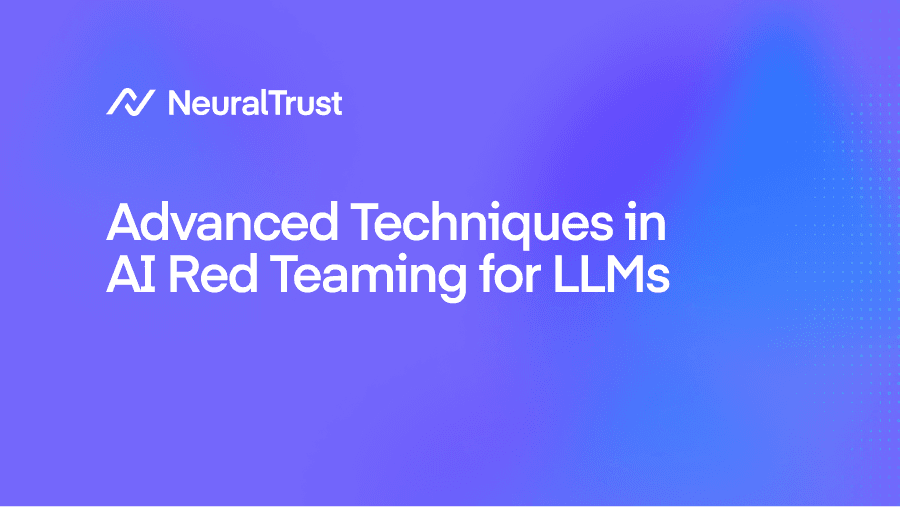As LLMs become central to business operations, organizations must move beyond traditional security measures and embrace proactive threat management strategies to ensure the integrity and reliability of their AI systems. In our previous post on AI Red Teaming, we explored the fundamental aspects of this security practice, outlining its role in identifying vulnerabilities and strengthening AI defenses.
In this article, we dive deeper into advanced AI red teaming techniques, the evolving threat landscape, and how organizations can implement comprehensive security frameworks to safeguard their LLM investments while maintaining compliance with increasingly stringent regulations.
Identifying and Addressing Emerging LLM Threats
As AI systems grow in complexity, so do the tactics employed by adversaries. Attackers continuously develop new methods to exploit LLMs, bypassing existing security controls through data poisoning, prompt injections, and adversarial manipulations. Proactively identifying and addressing these threats requires a deep understanding of their evolving nature and the ability to implement adaptive security frameworks. You can see a full analysis of the New Risks in the Era of Gen AI in our comprehensive guide. However, these are the main categories of emerging threats:
- **Dynamic Adversarial Attacks**: Attackers continually refine their techniques, creating threats that evolve in response to implemented security measures. AI systems must be able to adapt to these changing attack patterns.
- Data Poisoning Risks: Malicious training data injections can corrupt model learning, leading to biased or harmful AI outputs that degrade system reliability.
- Prompt Injection Exploits: Attackers manipulate input prompts to override system safeguards, forcing LLMs to produce unintended or unauthorized responses.
- Compliance and Legal Challenges: New AI regulations continue to emerge worldwide, requiring organizations to align AI deployments with ethical and legal standards to avoid liability.
- AI Model Interpretability: A lack of transparency in AI decision-making complicates security assessments, making it harder to predict and mitigate model vulnerabilities.
Organizations that fail to address these threats risk compromised AI integrity, financial losses, regulatory fines, and reputational damage. AI red teaming plays a crucial role in mitigating these risks by proactively identifying vulnerabilities and reinforcing system security.
5 Advanced Techniques in AI Red Teaming for LLMs
AI red teaming extends beyond traditional security testing—it is a dynamic, evolving practice that employs sophisticated techniques to simulate real-world adversarial scenarios, stress-testing AI systems to uncover hidden vulnerabilities. As cyber threats become more complex, organizations must leverage cutting-edge methodologies to ensure LLMs remain secure, robust, and resilient under attack. (Lessons From Red Teaming 100 Generative AI Products)
1. Adversarial Machine Learning: Simulating Real-World Manipulation
One of the most critical aspects of AI red teaming is adversarial machine learning, where security teams deliberately introduce malicious inputs to probe weaknesses in model robustness. These adversarial examples are carefully crafted to manipulate LLM behavior, revealing vulnerabilities in decision-making, response generation, and data processing. Through iterative testing, security teams can assess how susceptible models are to prompt injection, model inversion, and evasion attacks, allowing them to fine-tune security defenses.
2. Ethical Hacking Simulations: White-Hat AI Security Testing
Just as traditional cybersecurity employs penetration testing to assess vulnerabilities in IT infrastructure, ethical hacking simulations apply similar methodologies to LLMs. Security teams, often known as white-hat hackers, conduct controlled cyberattacks against AI models, testing their ability to withstand real-world attack methods. This includes jailbreaking AI restrictions, exploiting loopholes in system design, and attempting unauthorized data extraction. By simulating threat actor techniques, organizations can proactively patch security flaws before malicious entities exploit them.
3. Automated Threat Intelligence: AI-Powered Security Monitoring
With the rapid evolution of LLM threats, static security defenses are no longer sufficient. Organizations must leverage automated threat intelligence, where AI-driven security tools continuously analyze, predict, and adapt to emerging threats. These systems monitor for anomalies in AI behavior, unauthorized model interactions, and evolving adversarial tactics, enabling real-time risk detection and mitigation. This continuous feedback loop enhances LLM resilience, ensuring AI models remain protected against the latest adversarial advancements.
4. Cross-Domain Testing: Industry-Specific Threat Assessments
Not all AI applications face the same risks—LLMs deployed in finance, healthcare, and legal sectors encounter vastly different adversarial challenges than those used in e-commerce or customer servic*. Cross-domain testing ensures that AI security measures are tailored to industry-specific vulnerabilities, reinforcing model robustness across different operational environments. This includes evaluating compliance risks in regulated industries, bias detection in AI-generated content, and fraud prevention in financial transactions.
5. Continuous Adaptive Testing: Keeping Pace with Evolving Threats
Unlike static security measures, AI red teaming must be an ongoing process. As new threat vectors emerge, organizations must regularly update adversarial testing methodologies, ensuring their LLMs are prepared for previously unseen attack techniques. Continuous adaptive testing involves integrating real-time threat intelligence, refining AI defense strategies, and maintaining active monitoring of LLM interactions. This iterative approach ensures AI systems are resilient, self-learning, and capable of adapting to new security challenges.
From Reactive Defense to Proactive AI Security
These advanced AI red teaming techniques allow organizations to move beyond passive security measures and adopt a proactive, offense-driven approach to securing LLMs. By integrating adversarial machine learning, ethical hacking, automated threat intelligence, and industry-specific risk assessments, businesses can anticipate, counteract, and neutralize threats before they materialize. Red teaming is no longer optional—it is an essential component of responsible AI deployment in an increasingly complex security landscape. (Advancing red teaming with people and AI)
Developing a Robust AI Red Teaming Framework
Implementing an AI red teaming framework is essential for organizations seeking to integrate security into their AI lifecycle. This structured approach ensures continuous monitoring, rapid threat response, and alignment with compliance mandates.
- Risk Assessment Protocols: Establishing risk levels based on AI use cases, potential attack surfaces, and business impact.
- Scenario-Based Testing: Developing adversarial test cases tailored to the organization’s specific AI applications.
- Compliance Integration: Aligning security strategies with GDPR, HIPAA, EU AI Act, and other AI regulations.
- Collaboration Across Teams: Security teams, AI engineers, and compliance officers must work together to ensure end-to-end AI security.
- Incident Response Planning: Defining escalation protocols and ensuring rapid mitigation in case of AI security breaches.
By embedding AI red teaming into enterprise security strategies, organizations can proactively defend against threats, reducing downtime, financial losses, and reputational risks.
Real-World Applications of AI Red Teaming
AI red teaming is already being implemented across multiple industries, helping organizations secure their AI deployments against malicious actors.
Industry Use Cases
- Financial Services: Banks and fintech companies use AI red teaming to detect fraudulent activities and prevent financial exploitation.
- Healthcare Sector: AI security frameworks ensure patient data privacy and compliance with HIPAA to safeguard sensitive health records.
- Retail Industry: AI red teaming helps prevent misinformation in AI-driven customer interactions, ensuring accurate product recommendations and fraud prevention.
These real-world implementations highlight the critical role of proactive AI security measures in maintaining business integrity and consumer trust.
NeuralTrust’s Proactive AI Security Solutions
NeuralTrust offers a cutting-edge AI red teaming platform that enables organizations to implement proactive security defenses for their LLM deployments.
- Automated Security Audits: AI-driven red teaming simulations to continuously detect vulnerabilities before exploitation.
- Regulatory Compliance Tools: Integrated compliance modules ensuring alignment with global AI standards like GDPR and HIPAA.
- Adaptive Security Algorithms: AI-powered detection models that identify and neutralize evolving threats in real-time.
- Integrated Risk Management Dashboards: Centralized security monitoring for improved visibility and faster response times.
With NeuralTrust’s security-first approach, organizations gain full-stack protection against adversarial AI threats while ensuring compliance and operational continuity.
Conclusion
Proactively managing threats with AI red teamin* is no longer optional—it’s a necessity for organizations deploying LLMs at scale. Security teams must move beyond reactive defenses and adopt continuous, adaptive security frameworks that protect against evolving threats.
By implementing advanced AI red teaming techniques, risk assessment protocols, and compliance-driven security models, businesses can fortify their AI investments, ensuring resilience, compliance, and long-term sustainability.
Secure your LLM deployments with NeuralTrust’s AI red teaming platform. Our proactive AI security solutions provide automated risk assessments, compliance integration, and real-time threat intelligence, ensuring your AI applications remain protected at every stage.
Request a demo today and take control of your AI security strategy with NeuralTrust’s advanced threat management solutions.



